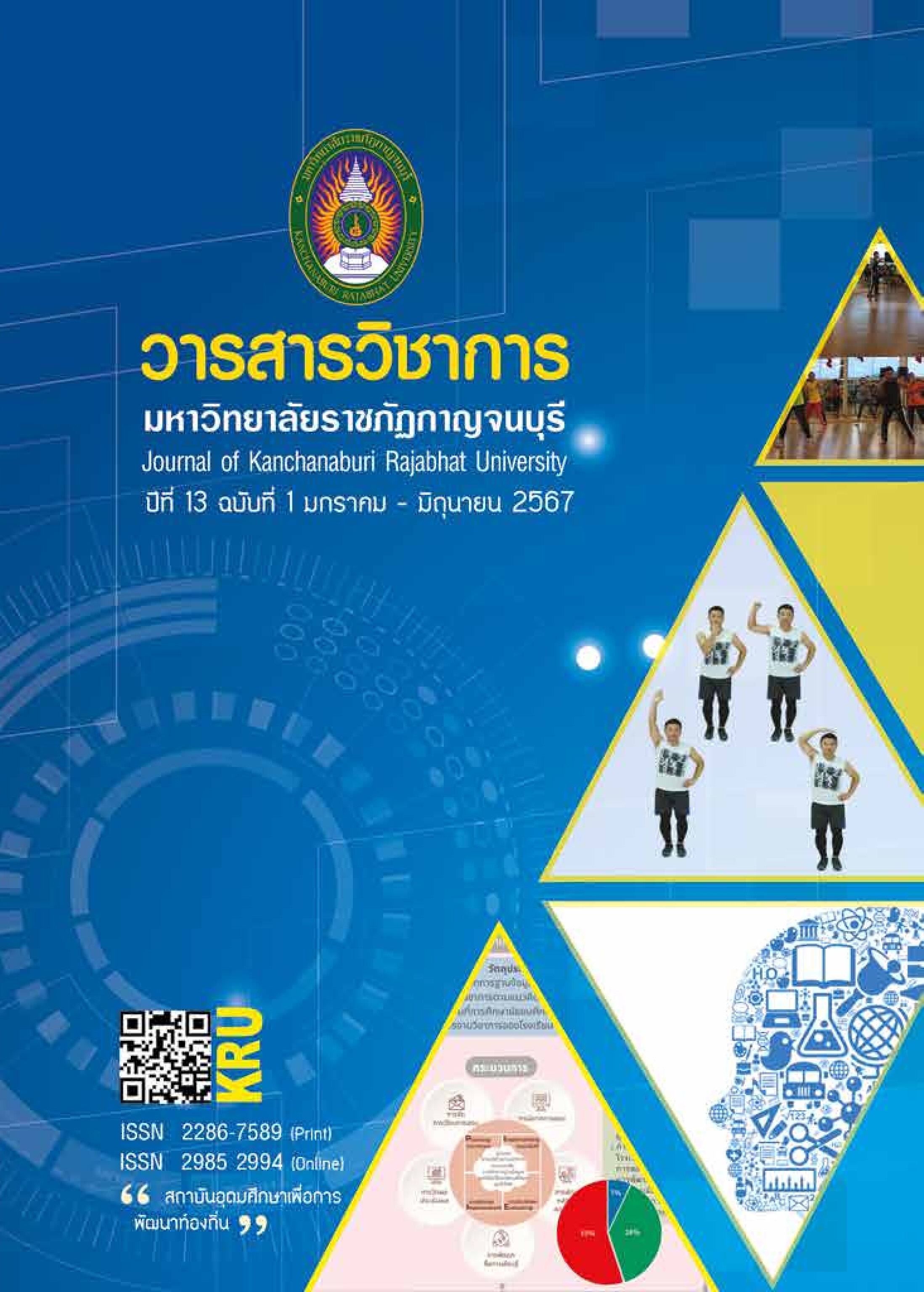เทคโนโลยีในการฟื้นฟูภาวะถดถอยทางการเรียนรู้สำหรับผู้เรียนในยุคชีวิตวิถีถัดไป
Main Article Content
Abstract
In the next phase of life, known as "The Next Normal," which is saturated with digital technology influencing every aspect of life, it is evident that digital technology plays a significant role in the recovery of learners' learning, especially during periods of learning loss resulting from the COVID-19 pandemic. This has led to the implementation of urgent recovery measures in learning, termed "RECOVER," which include: 1) Access to Education: Promoting access to learning resources through online channels; 2) Quality of Learning: Promoting the development of learning resources and teaching materials suitable for the current situation, creating learning communities, and supporting remote learning; and 3) Mental Health: Providing mental health care services and promoting adaptation to the current situation, including linking with relevant mental health service providers. Education in "The Next Normal" should adopt a blended learning approach to enhance learning efficiency, reduce learning gaps, and increase the chances of success for each learner equally. Active Learning management is a learner-centered approach that emphasizes learner participation in learning, critical thinking, problem-solving, and creativity. In the assessment of learning outcomes, it is essential to consider using appropriate tools and methods for fair assessment. Teachers should use assessment results to improve teaching processes appropriately. Technology plays a crucial role in recovering learning loss, including: 1) Online Learning Platforms: Helping learners access learning content conveniently and quickly from anywhere; 2) Digital Learning Tools: Enabling diverse and participatory learning formats; 3) Immersive Learning: Facilitating easier learning by integrating virtual information with the real world, enhancing understanding and learner involvement in learning; and 4) Artificial Intelligence Learning Technology: Utilizing AI to tailor learning to individual needs. Therefore, technology in recovering learning loss plays a crucial role in enabling learners to reach their full potential in "The Next Normal."
Article Details

This work is licensed under a Creative Commons Attribution-NonCommercial-NoDerivatives 4.0 International License.
References
กรกมล ศรีวัฒน์. (2566). เมื่อการศึกษาเผชิญหน้า AI: แง่มุมไหนที่การศึกษาไทยต้องเตรียมตัว. ค้นเมื่อ ตุลาคม 16, 2566,
จาก https://www.the101.world/ai-for-teaching-and-learning.
กรุงเทพธุรกิจ. (2565). เมื่อเด็กยุคโควิดเผชิญภาวะ "การเรียนรู้ถดถอย" รัฐต้องแก้อย่างไร?. ค้นเมื่อ ตุลาคม 1,
, จาก https://www.bangkokbiznews.com/social/1007890.
แก้วเกล้า รอบรู้. (2566). Extended Reality (XR) คืออะไร?ทำงานอย่างไร ต่างจาก AR/VR ขนาดไหน. ค้นเมื่อ ตุลาคม 16, 2566,
จาก https://hocco.co/blog/extended-reality/.
จตุรงค์ พะยอมแย้ม. (2564). การศึกษาไทยในยุค next normal. ค้นเมื่อ ตุลาคม 1, 2566,
จาก https://il.mahidol.ac.th/th/newsletter64-page-9/.
ปาริชาติ ปรีชากร. (2565). การจัดการเรียนการสอนในยุคชีวิตวิถีถัดไป (The Next Normal). ค้นเมื่อ ตุลาคม
, 2566, จาก https://bsru.net/การจัดการเรียนการสอนใน/.
เปรมินทร์ สิงห์ซอม และ พระมหาไพจิตร อุตฺตมธมฺโม. (2565). การสอนภาษาอังกฤษในโรงเรียน สังกัดองค์กร
ปกครองท้องถิ่น ในยุค New normal สู่ยุค Next normal. วารสารนิสิตวัง, 8 (2), 1-11.
พรชัย อินทร์ฉาย. (2565). สสวท. หนุนการฟื้นฟูภาวะถดถอยการเรียนรู้วิทย์-คณิต-เทคโนโลยี. ค้นเมื่อ ตุลาคม
, 2566, จาก https://www.ipst.ac.th/news/26624/20220519_ipst-go-digital.html/.
ภูษิมา ภิญโญสินวัฒน์. (2563). จัดการเรียนการสอนอย่างไรในสถานการณ์โควิด-19: จากบทเรียนต่างประเทศ สู่การจัดการเรียนรู้ของไทย. ค้นเมื่อ ตุลาคม 16,
, จาก https://tdri.or.th/2020/05/examples- of-teaching-and-learning-in-covid-19-pandemic/.
วิจารณ์ พานิช. (2565). เปลี่ยนวิกฤตการเรียนรู้ถดถอย เป็นโอกาสปฏิรูปการศึกษาเพื่อเด็กทุกคน. ค้นเมื่อ ตุลาคม 16, 2566,
จาก https://thepotential.org/knowledge/learning-recovery.
วีนัส กัลปกรณ์. (2566). เจาะลึกเทคโนโลยี VR/AR และเหนือกว่าด้วย MR แห่งยุค Metaverse . ค้นเมื่อ ตุลาคม 1, 2566,
จาก https://thegrowthmaster.com/blog/vr-ar-mr-metaverse.
ยศวีร์ สายฟ้า. (2565). Learning Loss ภาวะการเรียนรู้ถดถอย. ค้นเมื่อ ตุลาคม 2, 2566,
จาก https://research.eef.or.th/learning-loss-recession/.
ยืน ภู่วรวรรณ. (2564). โควิด 19 กับ การศึกษาวิถีใหม่. ค้นเมื่อ กันยายน 30 , 2566,
จาก https://learningdq-dc.ku.ac.th/course/?c=3&l=1.
สำนักงานเลขาธิการสภาการศึกษา. (2565). การศึกษาภาวะถดถอยทางการเรียนรู้ของผู้เรียนระดับการศึกษาขั้นพื้นฐานในสถานการณ์โควิด-19 : สภาพการณ์
บทเรียน และแนวทางการพัฒนาคุณภาพการเรียนรู้. ค้นเมื่อ ตุลาคม 25, 2566, จาก https://opac01.stou.ac.th/multim/Gift_eBook
/167260.pdf.
สำนักงานเลขาธิการสภาการศึกษา. (2565). รายงานผลการศึกษาภาวะถดถอยทางการเรียนรู้ของผู้เรียนระดับการศึกษาขั้นพื้นฐานในสถานการณ์โควิด-19 :
สภาพการณ์ บทเรียน และแนวทางการพัฒนาคุณภาพการเรียนรู้. ค้นเมื่อ ตุลาคม 12, 2565, จาก http://backoffice.onec.go.th/uploads/Book/1932-
file.pdf.
เสกสันต์ พันธุ์บุญมี. (2564). Digital Transformation จาก New Normal สู่ Next Normal. ค้นเมื่อ พฤศจิกายน 2, 2566,
จาก https://www.depa.or.th/th/article-view/digital-transformation-new-normal-next-normal.
อติวงศ์ สุชาโต และคณะ. (2566). สกศ.ใช้ CSC โมเดลแก้ภาวการณ์เรียนรู้ถดถอยของเด็กไทย. ค้นเมื่อ พฤศจิกายน 2, 2566,
จาก www.krupatom.com/wp-content/uploads/2023/03/2008-file.pdf.
อรรถพล สังขวาสี. (2565). การศึกษาแนวทางการประยุกต์ปัญญาประดิษฐ์เพื่อพัฒนาทักษะการอ่านของผู้เรียนระดับประถมศึกษา. ค้นเมื่อ พฤศจิกายน 2, 2566,
จาก https://www.bangkokbiznews.com/social/992676.
Office of the Basic Education Commission. (2022). Office Policy Announcement Basic Education Commission, Fiscal Year 2023.OBEC,


